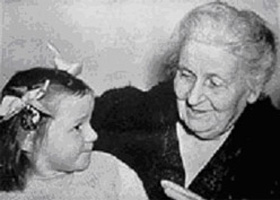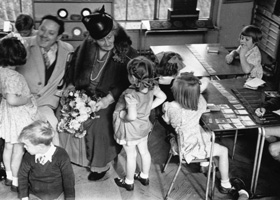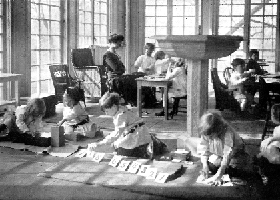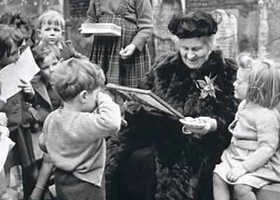"The mediocre teacher tells.
The good teacher explains.
The superior teacher demonstrates.
The great teacher inspires."
- Maria Montessori
-
"The mediocre teacher tells.
The good teacher explains.
The superior teacher demonstrates.
The great teacher inspires."
- Maria Montessori
-




"The mediocre teacher tells. The good teacher explains. The superior teacher demonstrates. The great teacher inspires." - Maria Montessori
The Montessori method emphasizes the uniqueness of each child and recognizes that children are different from adults in the way they develop and think (they aren't just "adults in small bodies"). Dr. Montessori believed in children's rights, the value and importance of children's work to develop themselves into adults, and that this development would lead to world peace.
The Montessori method discourages traditional measurements of achievement (grades, tests) as negative competition that is damaging to the inner growth of children. Feedback and qualitative analysis of a child's performance does exist, but is generally provided in the form of a list of skills, activities and critical points, and sometimes a narrative of the child's achievements, strengths and weaknesses. Deficiencies in one area are treated as places to improve, not as failures.
The Montessori method is based on observing young children and learning from them about their characteristics and needs. Each child is nurtured and guided in individually-paced learning and development. As an educational approach, the Montessori method focuses on the individuality of each child in respect of their needs or talents, as opposed to the needs of the class as a whole. A goal is to help the child maintain their natural joy of learning.
The Montessori philosophy encourages a great deal of independence, freedom within appropriate limits, which is always linked with responsibility. The youngest children are guided in "practical life" skills towards taking care of themselves, maintaining their environment, and interacting gracefully with others. Integral to the practical life activities are essential skills such as focusing of attention, hand-eye-body coordination, and the students' ability to accomplish what they set out to do. The Montessori Method states that satisfaction, contentment, and joy result from the child having access and guidance to be full participants in daily activities. There are also attractive and enticing materials with which the child gains a foundation for academics and other skills.
Independence with Co-operation
In a true Montessori school you will find independent children who are encouraged not only to do things for themselves but also to think for themselves. You will find children who have learnt how to explore and solve problems for themselves. Most importantly, you will see small children - who are often perceived as only being aware of their own needs - helping each other and putting things away without being asked to. They also perform unanticipated acts of kindness purely to benefit the group as a whole.
Absorbing Through The Senses
The Montessori approach is based on the natural laws of human development. Maria Montessori observed that children under six absorb limitlessly and effortlessly from the world around them, and in doing so, lay down all the foundations for later life. Maria Montessori determined that every child has a special mind that she called, 'The Absorbent Mind' – a strong desire to explore everything around them using their senses and drive to become independent. She identified certain windows of opportunity for the children that she called, 'Sensitive Periods', during which the child is drawn to the things they need to help them develop to their full human potential.
Learning with Each Other
Everything in the classroom is designed to support these windows of opportunity. The classrooms are intended to allow the child to become independent with the materials being child-sized and the equipment is laid out in an orderly fashion on shelves that are easily accessible by the children. The equipment is aesthetically pleasing and well cared for, which encourages the children to take care of it also. Children between the ages of 2 ½ - 6 are grouped together in their own mini society. The younger children learn from watching the older children, and the older children benefit by helping the younger ones. Mixing the age groups allows the children to develop socially, intellectually, and emotionally, and is an essential part of the Montessori classroom.
Hands on Experience
The curriculum is divided into five main areas:
Practical Life gives the children the opportunity to practice skills of everyday life, but, also enables them to develop eye/hand co-ordination, gross-to-fine motor skills and concentration.
Sensorial allows the children to capitalize on the concept that children use their 'senses' to learn.
Math is taught using concrete materials thereby helping them learn and really understand mathematical concepts because they are being presented in a tangible form.
Language is an area that introduces the child to reading and writing as soon as they enter the classroom. Each child works with a series of activities/materials that gradually build all the individual skills required so that when they are ready to read and write, it is a natural progression.
Cultural includes: geography, history, biology, botany, zoology, art and music, and they are covered with a hands-on approach that is based on the fact that children learn more effectively from their own experiences.
In Their Own Time
In a traditional Montessori classroom you will observe children choosing their own activities independently and moving from one activity to the next with purpose. Children will always return their work to the shelf after they are finished with it, so concluding their work cycle. You will experience a calm atmosphere and see young children concentrating for remarkable lengths of time. Children work either independently, in a group or with a friend.
The Teacher (or as Montessori called them, "The Directress")
In a Montessori classroom, the child is guided by a trained adult who will show the child how do to things that he/she is ready for after which the child can work on the materials independently. The Directress observes the child and only interferes if the child is not working with the materials productively, or, indeed is having difficulties. Children work at their own individual pace and naturally develop a rhythm and work pattern. Each child's needs are assessed through observation by the Directress and new materials introduced when the child is developmentally ready. New knowledge is always built on what the child already knows and since everything in the classroom also prepares for later activity, the child is able to move gradually through the curriculum, and so develop his/her skills effortlessly.
Maria Montessori
Dr. Maria Montessori was born in 1870, Italy. She began her life not as an educator, but as the first female Dr. of medicine. After many years and experience in private practice, hospital work and research, she undertook further studies in education, philosophy, psychology, and anthropology as a basis for her growing commitment to education. When Maria Montessori was 37 years old, she took responsibility for a group of underprivileged children in Rome, founding her first 'Children's House' (Casa dei Bambini).
Her unique approach with these children led to surprising results. Through her experiences with these children, Maria Montessori observed that when previously unruly children were provided with experiences which mirrored their own stage of development, the children easily became absorbed in purposeful activities. Challenging activities attracted greater interest than toys. Gradually the children genuinely wanted to do things for themselves and were less interested in rewards given for working than in the activity itself. To Maria Montessori this became an inherent characteristic of the child and she came to believe that the child's education should proceed in such a way as to provide an environment in which the spontaneous activity of the child would be left free and manifest itself.
|
|